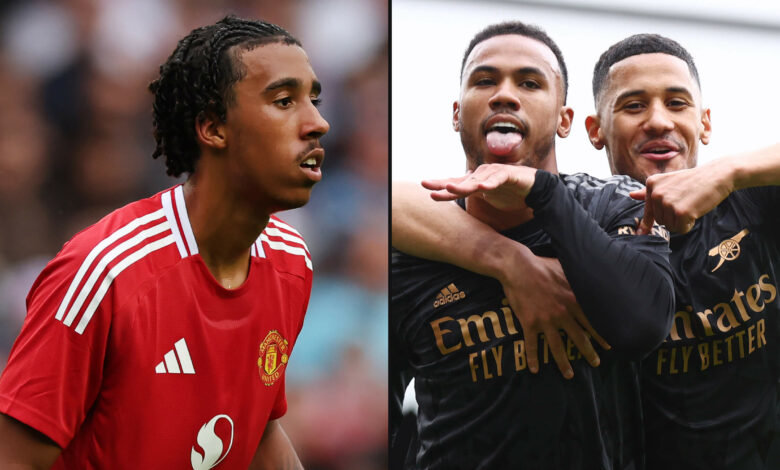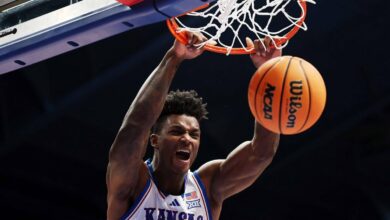How France Became the Premier League’s Biggest Retail Market

Manchester United’s £52million signing of Leny Yoro was a deal that woke up European football last week.
Most observers had expected the young Lille defender to end up at Real Madrid, but then United came along, offering a greater return and long-term challenge, and won the battle for his signature.
It is the biggest transfer of the Premier League summer and a huge vote of confidence in someone so young. The market in which United have chosen to invest such a significant sum should come as no surprise, however.
In Ligue 1, the top French division where Yoro made his breakthrough last season, the Premier League’s 20 clubs have collectively spent more money than any other foreign league in the past decade.
Spending stood at £1.81 billion ($2.34 billion) over the past 10 years leading up to this summer and is likely to top £2 billion in the next six weeks. The sheer size of the numbers making the switch to the Premier League from French clubs — 145 players and counting — is also unprecedented.
Since 2014, no other European league has taken in as much money from the Premier League in transfer fees as the French top division, although Spain’s La Liga and Germany’s Bundesliga are not far behind.
La Liga used to be the biggest spender for Premier League clubs. In the 10 years between 2004-05 and 2013-14, Spain’s top division easily brought in the most transfer income from the Premier League, with spending 27 percent higher there than in France.
In the decade that followed, a further £1.76bn was spent on La Liga players, but others, notably Germany, have caught up. Bundesliga clubs sold players for a total of £1.72bn between 2014-15 and 2023-24, with last summer’s spend the highest ever.
In a transfer window that saw RB Leipzig sell Josko Gvardiol to Manchester City, Christopher Nkunku to Chelsea and Dominik Szoboszlai to Liverpool, the Premier League collectively spent £378m on Bundesliga players. The running total since 2018 actually stands at £1.26bn, slightly more than Ligue 1 over that shorter period of review.
Serie A was also a market that attracted the attention of the Premier League last summer, with over £300m in transfer fees being raised, but it is still the least popular of Europe’s big five leagues, with a return of £1.48bn over 10 years.
Despite this, France still stands apart in the overall spending chart, having been the most popular place to shop in four of the last nine seasons. And early movements this summer, particularly Yoro, would suggest it’s anything but a passing fad.
Despite lagging behind rival leagues La Liga, Bundesliga and Serie A, and lagging behind in UEFA’s national coefficient rankings, Ligue 1 continues to serve as Europe’s premier talent factory. In 19 of the past 20 years, at least 10 players have been bought from Ligue 1 clubs, according to respected website Transfermarkt. In 2022-23, that total was 22, with Premier League clubs spending more (£312m) on Ligue 1 players than Ligue 1 clubs did (£153m).
There have been some costly mistakes, such as Arsenal’s £72m deal to sign Nicolas Pepe – also from Lille – in 2019, but recent seasons have seen a string of success stories, with Gabriel (Arsenal), Bruno Guimaraes (Newcastle United), William Saliba (signed by Arsenal from St Etienne in 2018 but who spent the next three seasons on loan at Ligue 1 clubs) and former Lille man Amadou Onana, who yesterday swapped Everton for Aston Villa for £50m, all flourishing.

Bruno Guimaraes is a hit at Newcastle United (Daniel Pockett/Getty Images)
The Athletics spoke to a number of figures working in football to gauge why Ligue 1 had become the preferred shopping market for English clubs. Those who responded asked to remain anonymous, either because they were not authorised to speak or because of commercial sensitivity, but their answers were revealing.
A senior Premier League figure pointed to the physical and athletic qualities of Ligue 1 and the potential for players to develop quickly under better coaching in England. A senior agent, meanwhile, cited the value for money that Ligue 1 traditionally offers when compared to the output of data. Players there often tick all sorts of boxes when they impress at a level that requires technical prowess.
It is difficult to pinpoint a specific moment when French football began to attract so much attention from Premier League clubs.
Perhaps it was the impact of Eric Cantona, Manchester United’s swashbuckling No.7 of the 1990s, or David Ginola, the dazzling winger for Newcastle United and Tottenham Hotspur, but more likely it was the deep marks left by their French connection at Arsenal under Arsène Wenger.
Alongside Nicolas Anelka, Emmanuel Petit and Robert Pires were Sylvain Wiltord and — via brief spells in Serie A — Thierry Henry and Patrick Vieira. Wenger found technically adept, physically strong players at prices far below their English equivalents. In all, 28 French players signed for Arsenal during Wenger’s 22 years as manager.
Others soon followed where he had gone. It made sense to sign players from Ligue 1 – French or otherwise. Newcastle United signed five players from French clubs in 2012-13 alone, a season that was, remarkably, the first in which Premier League clubs spent more than £100m on imports from a single league. It was the year that Chelsea signed Eden Hazard from Lille, Olivier Giroud left Montpellier to join Arsenal and Spurs brought in Hugo Lloris from Lyon – three huge deals, but each one boosting the perceived reputation of Ligue 1 targets.

Eden Hazard was a game changer when he signed for Chelsea (William West/AFP via Getty Images)
French football also tends to field younger players, offering that potential and promise to foreign prospects. UEFA’s annual report, The European Club Footballing Landscape, found that 39 percent of all total domestic minutes played in France came from players aged 23 or under during the 2021-22 season. That made it the youngest profile among Europe’s major leagues, well below the 26 percent of Premier League minutes played by under-24s and 20 percent in La Liga, where spending by English clubs has fallen in recent years.
Only the Dutch Eredivisie, another league that has come under heavy attack from English clubs in recent seasons, had a comfortably younger demographic than Ligue 1, with 47 per cent of minutes played by players under the age of 24. By the end of that assessment period covered in UEFA’s report, Premier League clubs had spent £240m on players from the Dutch top flight in 2022-23, including Antony, Lisandro Martinez, Cody Gakpo and Noni Madueke.
The Premier League’s financial clout is becoming harder for European rivals to challenge and it is Ligue 1, with its modern challenges over TV rights, that has become more vulnerable. A recently struck domestic deal with DAZN and beIN Sports is said to be worth just £420m per season, a figure dwarfed by the Premier League’s total TV packages of over £3bn a year. Ligue 1 rights have effectively declined in value since their peak in the 2016-20 cycle.
Spanish, German and Italian clubs are feeling the same pressure, but not as in France. Selling players has become a fundamental part of their business model, and few do it better than Lille, who sold Yoro to Manchester United last week. Over the past five years, Lille, who finished fourth in Ligue 1 last season, have sold £250m worth of players to Premier League clubs, including Sven Botman, Carlos Baleba, Onana, Gabriel and Pepe.

Lille sold Nicolas Pepe to Arsenal for £72m (Jeff Pachoud/AFP via Getty Images)
Lyon, another big name in French football, are similarly adept. Their returns have also topped the £200m mark since 2019, with the likes of Lucas Paqueta (to West Ham), Guimaraes (Newcastle) and Tanguy Ndombele (Tottenham) sold for huge profits.
Ligue 1 still managed to achieve a net transfer fee of just under £30m last summer, a feat that goes further than Serie A and La Liga, but that was largely due to the lavish spending of Paris Saint-Germain, who have always been protected by the backing of ownership group Qatar Sports Investment.
PSG remain the only French club in the top 10 of Deloitte’s Football Money League, a list of European clubs that generate the most revenue. Marseille came in 20th place in the 2024 list, with Lyon in 29th, but the rest of Ligue 1, particularly those that don’t benefit from the extra revenue that European football brings, could see their revenues change with a single sale. English approaches are harder to say no to.
French football is therefore at the heart of the multi-club development plans. Chelsea owners BlueCo bought Strasbourg last year and Liverpool owners FSG were also in recent talks to buy Bordeaux, a historically great club currently languishing in the second division, before the talks collapsed last week. The same reasons for targeting French players in the transfer market are the motivations for taking ownership of his clubs.
No wonder, given that so many have made the switch from Ligue 1 to the Premier League. In total, 260 players were signed from the French top division between 2004 and 2024, a figure higher than Spain (245), Italy (192) and Germany (171).
The average cost of a transfer out of Ligue 1 at the time? Just under £9m.
The Premier League’s focus is broadening, with Germany’s Bundesliga attracting increasing interest in the Covid-19 years, but Ligue 1 remains the most fertile ground to find a new recruit. Yoro is proof of that.
(Top photos: Leny Yoro, Gabriel and William Saliba; all Getty Images)




